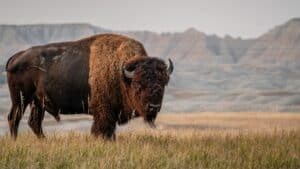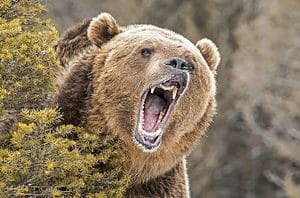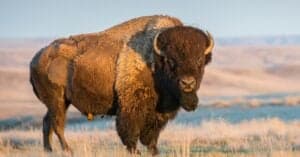Bison are an iconic symbol of the American West. This is most evident in Montana, where these majestic animals have roamed for thousands of years.
With a population estimated at over 5,000, Montana is home to one of North America’s largest bison herds. Bison play an important role in Montana’s ecosystem. They shape the landscape through grazing and movement patterns and provide food and habitat for many other species.
But the future of bison in Montana isn’t without its challenges. They continue to face threats from habitat loss and fragmentation, disease transmission from livestock, genetic introgression from domestic cattle, and climate change.
In this article, we discover the largest bison ever caught in Montana. We also provide an overview of bison in Montana, including their physical characteristics, adaptations to their habitat, predators, threats, current status, economic impact, controversies, and future outlook.
The Largest Bison Ever Caught In Montana
The largest bison ever caught in Montana scored an impressive 135 points. The trophy, whose hunter is unknown, is owned by Glenn M. Smith. It was picked up from an unknown location in 1997.
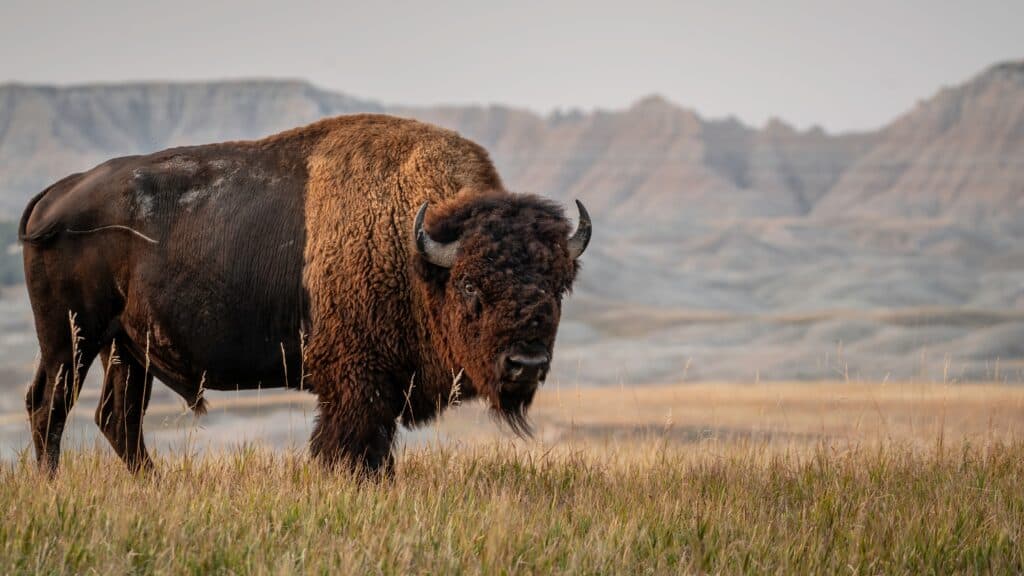
The largest bison ever caught in Montana scored an impressive 135 points.
©Tim Malek/Shutterstock.com
The Largest Bison Ever Caught Worldwide
The largest bison ever recorded worldwide weighed about 3800 lbs. It’s unclear where this massive bull was caught and the hunter involved.
Physical Characteristics
Bison are impressive animals with a distinctive appearance. In addition, they have several unique physical features that allow them to thrive in the harsh conditions of the American West.
Size And Weight
An adult male bison (bull) weighs up to 2,000 pounds and stands over 6 feet tall at its shoulder. Adult females, or cows, typically weigh 800-1,000 pounds and are slightly shorter than males. Bison has a stocky, muscular build and broad, hump-like shoulders.
Coat And Coloration
Bison have a thick, shaggy coat that varies from dark brown to reddish-brown in summer and can turn lighter in the winter.
The hair on their head, neck, and shoulders is longer than the rest of their body, forming a distinctive “mane.” Bison also have a beard and long tails, which they can hold straight up in the air when running.
Horns
Both male and female bison have horns composed of a bony core covered in a keratin sheath. Male bison have larger, more curved horns than females, which they use for fighting during mating season. Bison horns can grow up to 2 feet long and 20 inches in circumference.
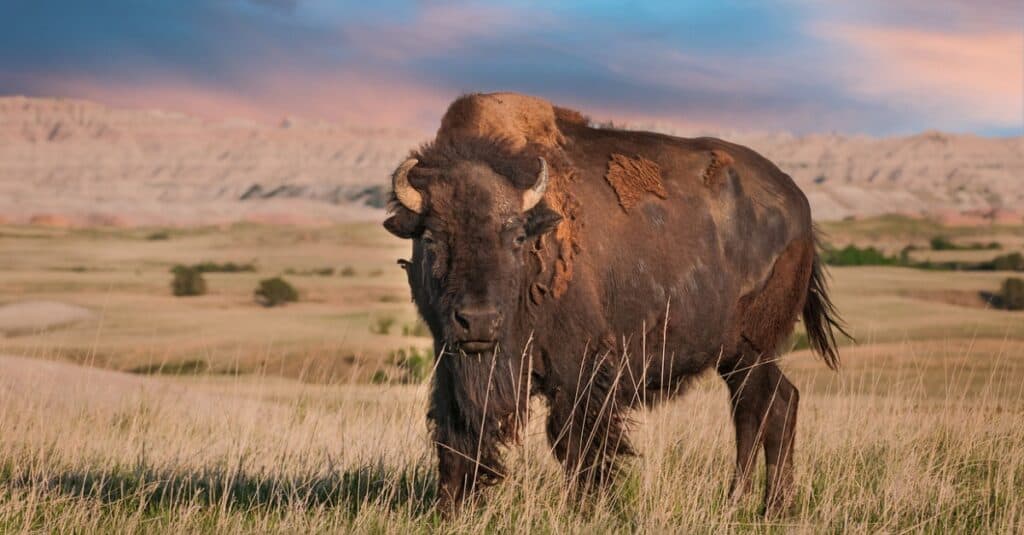
An adult male bison (bull) weighs up to 2,000 pounds and stands over 6 feet tall at its shoulder.
©Geoffrey Kuchera/Shutterstock.com
The Historical Context Of Bison In Montana
Bison have played a significant role in the history of Montana. Their story is intertwined with that of the indigenous peoples and early settlers who inhabited the region.
For thousands of years, bison were a crucial source of food, clothing, and shelter for Native American tribes such as:
These tribes hunted them on the Great Plains. But the nineteenth-century arrival of European settlers and explorers marked the beginning of a period of rapid decline for bison populations across North America.
Brief History Of Bison In North America
Bison are native to North America and have roamed for over 10,000 years. At their peak, bison populations are estimated to have numbered in the tens of millions. This made them one of the most abundant large mammals in the world.
Bison played a vital role in the ecosystem, shaping the landscape through their grazing and trampling behaviors and providing food and habitat for various other species.
Bison Population Decline In The Late 1800s
However, by the late 1800s, bison populations had been decimated by a combination of factors, including:
- Overhunting by settlers and commercial hunters
- Disease transmission from domestic cattle
- Habitat loss and fragmentation due to westward expansion and the construction of railroads
By 1890, North America’s bison population had been reduced to fewer than 1,000. The species was on the brink of extinction.
Early Conservation Efforts
Several conservation efforts were launched in the early twentieth century to save the bison from extinction. One notable effort was the creation of the American Bison Society in 1905. It worked to establish bison herds in national parks and other protected areas.
Today, bison populations have rebounded to an estimated 500,000 in North America. As a result, the species is no longer considered to be in immediate danger of extinction.
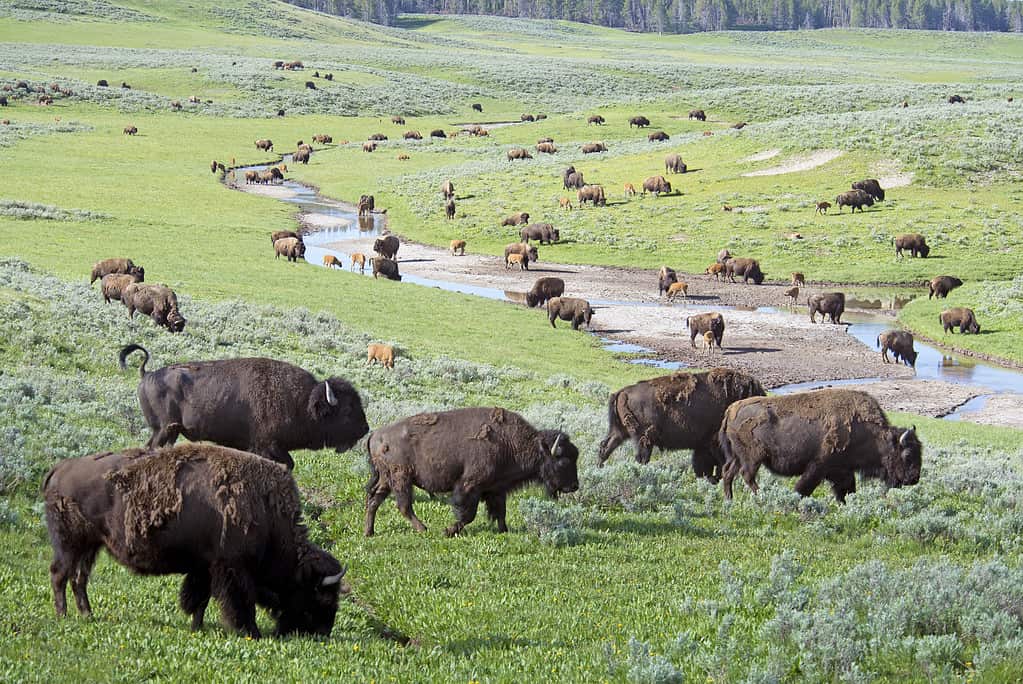
The bison was on the brink of extinction but conservation efforts have helped populations to rebound.
©iStock.com/Betty4240
Adaptations To Their Habitat
Bison are well adapted to the harsh conditions of the American West. They have various unique adaptations that allow them to thrive in their habitat.
Grazing Behavior
Bison are grazers and feed on various grasses, sedges, and other herbaceous plants.
Their grazing behavior has numerous ecological benefits, including:
- Maintaining grassland habitat
- Promoting plant diversity
- Providing food for various other species
Migration
Bison are also well known for their seasonal migrations. They help them find food and water in different parts of their range.
In Montana, bison typically move to lower elevations in winter to escape deep snow and harsh weather conditions. They return to higher elevations in the spring and summer to take advantage of abundant forage.
Social Structure
Bison are social animals and live in large groups or herds. They can number in the hundreds or even thousands.
Herds are typically led by a dominant male, or bull, and include cows and their offspring. Bison use vocalizations, body postures, and other behaviors to communicate and maintain social bonds within the herd.
Thick Coat And Insulation
Bison have a thick, shaggy coat that provides insulation against the cold. It also helps protect them from predators.
In addition, bison have a layer of fat beneath their skin that provides additional insulation and energy reserves during periods of scarcity.
Water Conservation
Bison can conserve water by extracting moisture from the vegetation they eat, allowing them to survive in dry, arid environments.
They can also go for long periods without drinking water. This allows them to survive in areas where water sources are scarce.
Strong Sense Of Smell
Bison have a strong sense of smell, which they use to detect predators and other potential threats. They also use their sense of smell to locate food and water sources and navigate their environment.
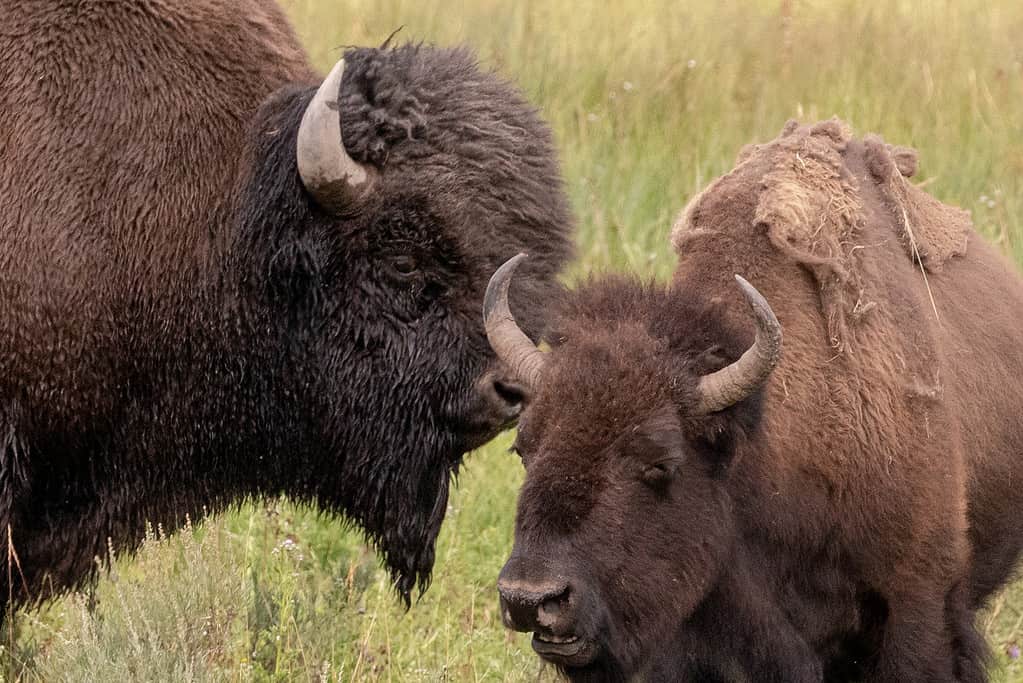
Bison are well adapted to the harsh conditions of the American West.
©iStock.com/htrnr
Predators
Despite their large size and formidable strength, bison are still vulnerable to predation from a number of different species. They include:
- Gray wolves
- Grizzly bears
- Mountain lions
- Humans
Gray Wolves
Gray wolves are one of the primary predators of bison in Montana. Wolves are pack animals capable of taking down large prey like bison, particularly if sick, injured, or isolated from the herd.
Grizzly Bears
Grizzly bears are another major predator of bison in Montana. Like wolves, grizzly bears are omnivores. They feed on a variety of food sources, including bison. But grizzly bears are more likely to scavenge on bison carcasses than actively hunt live bison.
Mountain Lions
Mountain lions, also known as cougars, are skilled predators capable of taking down large prey like bison. But they’re solitary hunters and typically target younger or weaker animals.
Humans
Humans have historically been one of the biggest threats to bison populations. For example, bison were hunted to near extinction during European colonization.
Today, the hunting of bison is heavily regulated in Montana. But collisions with vehicles and other forms of human encroachment continue to pose a threat to bison populations.
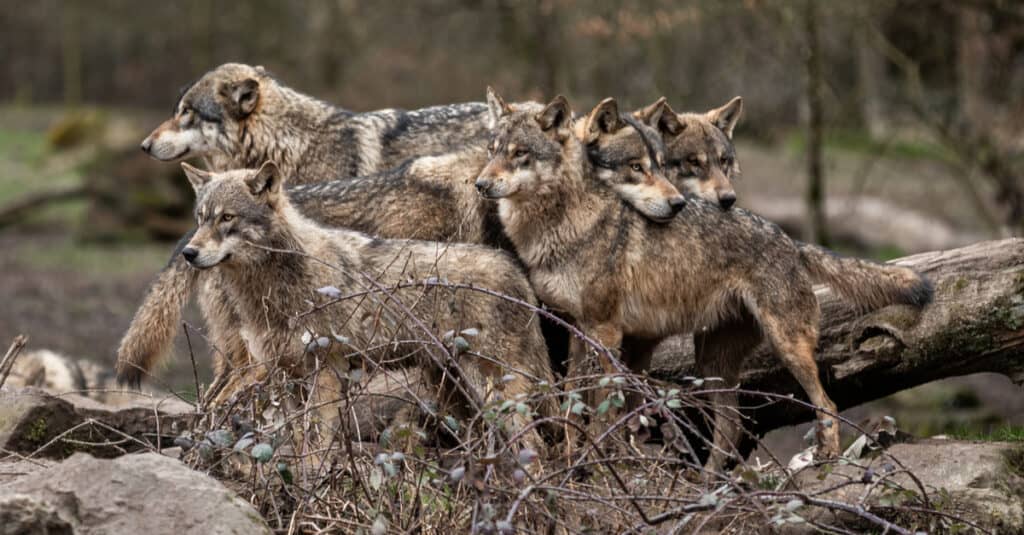
Gray wolves are one of the primary predators of bison in Montana.
©AB Photographie/Shutterstock.com
Threats To Bison In Montana
While bison populations in Montana have rebounded in recent years, they still face several threats that could impact their long-term survival. They include:
- Habitat loss
- Disease
- Hunting
- Climate change
Habitat Loss
One of the biggest threats to bison populations in Montana is habitat loss. As human development and other forms of land use continue to expand, bison are losing their traditional range and becoming increasingly fragmented.
Disease
The disease is another major threat to the bison population in Montana. Bovine tuberculosis and brucellosis are both present in bison populations in Montana. Therefore, they can have significant impacts on the health of individuals and the overall population.
Hunting
While bison hunting is heavily regulated in Montana, it remains a significant threat to the species long-term survival. Overhunting in the past is one of the reasons why bison populations in the state declined so dramatically. Careful management is needed to ensure that populations remain stable and healthy.
Climate Change
Climate change is also a growing threat to bison populations in Montana. Rising temperatures and changes in precipitation patterns can impact the quality and availability of forage and the timing of seasonal migrations.
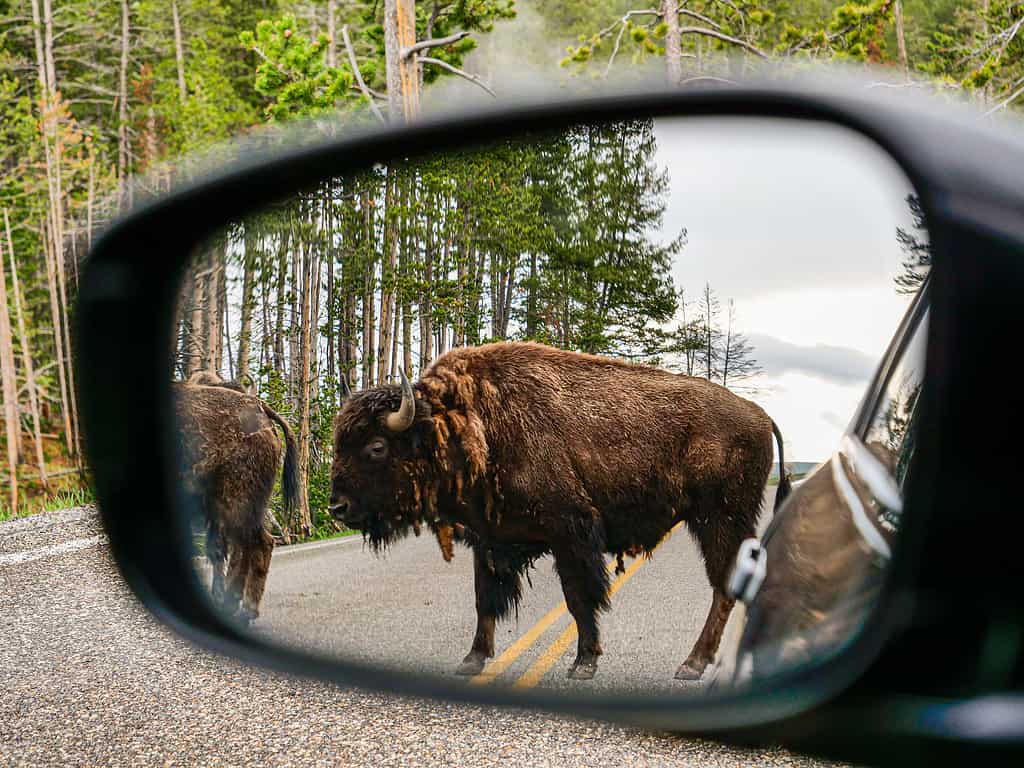
One of the biggest threats to bison populations in Montana is habitat loss.
©iStock.com/Joseph Tointon
Current Status Of Bison In Montana
Despite the threats faced by bison populations in Montana, there is a reason for cautious optimism about their long-term survival.
Population Size
The population of bison in Montana has rebounded significantly in recent years. There are approximately 5,500 bison in the state.
Protected Areas
A number of protected areas in Montana have been established to support bison populations, including:
- Yellowstone National Park
- American Prairie Reserve
These areas provide important habitats for bison to thrive and are critical to their long-term survival.
Conservation Efforts
Conservation efforts are also helping to support bison populations in Montana. They include:
- Habitat restoration
- Disease management strategies
These efforts ensure that bison populations remain stable and healthy over the long term.
Economic Impact Of Bison In Montana
Bison have long been important to Montana’s economy, with many economic benefits that extend from ranching to tourism.
Bison Ranching
Bison ranching is a growing industry in Montana, with many ranchers raising bison for their meat, hides, and other products. The industry provides a key source of income for many rural communities in the state.
Tourism
Bison also play a key role in Montana’s tourism industry. Many visitors come to the state to see bison in their natural habitat. In addition, the animals are a major draw for national and state parks.
Cultural Significance
Bison are important to Montana’s cultural heritage, with deep ties to the state’s indigenous communities. The animals are also recognized as a symbol of the state and are important to Montana’s identity.
Controversies Surrounding Bison In Montana
Despite their ecological and economic importance, bison have also been the source of controversy in Montana. As a result, several issues related to their management and conservation have emerged.
Brucellosis And The Risk to Cattle
One of the main sources of controversy around bison in Montana is the risk of brucellosis transmission to cattle. While bison aren’t the only carrier of the disease, they’re often blamed for outbreaks among livestock. This has led to pressure to keep bison populations low.
Hunting And The Ethics Of Wildlife Management
Bison hunting has also been a source of controversy in Montana, with debates around the ethics of hunting and the impact on population dynamics. While hunting is carefully regulated, it’s still a threat to the species long-term survival.
Land Use And Habitat Conservation
Habitat conservation and land use are also sources of controversy regarding bison in Montana. As human development continues to expand, the question of how to balance economic growth with conservation efforts is complex, with different stakeholders often having competing interests.
Tribal Sovereignty And Cultural Significance
The cultural significance of bison to Montana’s indigenous communities has also been a source of controversy. Issues around tribal sovereignty and the role of bison in traditional cultures have led to debates around management and conservation strategies.
The Future Outlook For Bison In Montana
The future outlook for bison in Montana is both hopeful and uncertain, with ongoing conservation efforts and continued challenges to their management and protection.
Restoration And Recovery Efforts
Many conservation organizations and government agencies are actively working to restore bison populations in Montana, with efforts focused on:
- Habitat restoration
- Disease management
- Other strategies to support population growth
Climate Change
The impacts of climate change on bison populations in Montana remain uncertain. Changes in temperature and precipitation patterns could significantly impact the availability of food and water resources for bison. This could impact their long-term survival.
Key Takeaways
Bison have played an important role in Montana’s ecology, economy, and cultural heritage for centuries.
Their physical characteristics and adaptations have allowed them to thrive in various habitats. However, their conservation and management remain critical to ensuring their long-term survival.
While the future outlook for bison in Montana is uncertain, ongoing restoration and recovery efforts and continued attention to the challenges and controversies surrounding their management and conservation offer reasons for hope.
Where Is Montana Located On a Map?
Montana is located in the Mountain West region in the northwest of the United States. It shares a border with Idaho to the west, Wyoming to the south, North Dakota and South Dakota to the east, and the following Canadian provinces to the North: Alberta, British Columbia, and Saskatchewan.
The photo featured at the top of this post is © Jack Dykinga, Public domain, via Wikimedia Commons – License / Original
Thank you for reading! Have some feedback for us? Contact the AZ Animals editorial team.



